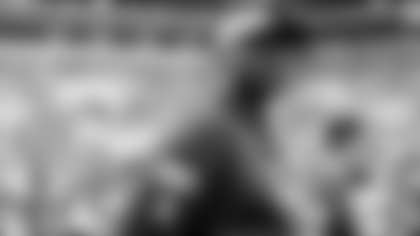As we've spent the week examining the five times in which a team traded down from the fifth-overall pick during the NFL Draft, we ran into a mega-deal on Wednesday. The unforgettable – and, ultimately, ill-advised – decision by the 1999 New Orleans Saints to trade their entire draft for one player involved no fewer than nine picks scattered across two drafts.
Today's focus is much simpler, and probably more applicable to the situation in which the Tampa Bay Buccaneers find themselves heading into the 2019 draft. The Buccaneers are slotted fifth in the first round and could be motivated to swing the sixth such trade-down, if the circumstances are right.
The purpose of looking back at trade-down scenarios from the fifth pick is to see what the stakes were and how well it worked out for both teams involved, and we're looking at one of those five previous trades each day this week. On Monday, we recalled the most recent such deal, which happened to be executed by the Buccaneers themselves in 2012. That was a very small slide down, from #5 to #7. (That installment also runs down the sixth other drafts in which the fifth pick was traded in different sorts of deals.) On Tuesday, we rewound to the Browns-Jets deal of 2009, which was a much bigger trade because Cleveland moved all the way down to #17. That was nothing, however, to the Saints' Mike Ditka swinging for the fences in '99 to get Texas running back Ricky Williams.
Our fourth installment brings us back around to a deal like the one the Bucs pulled off seven years ago. In fact, the structure was almost the same, although the payoff for the team trading down was a little better. In fact, the more interesting part of this trade was what happened to the picks before and after the central deal. Let's take a closer look.
**
Trade #4: Rams Began Multi-Trade Move Down, Collecting Assets
The Trade: The Los Angeles Rams (who would move to St. Louis the next year) send the fifth-overall pick to the Indianapolis Colts for the seventh-overall pick and a 1994 third-round pick, number 83 overall. The Colts had acquired both of the picks they used in this deal from the Atlanta Falcons a month earlier. We'll discuss that deal below.
Trade Value: There are two "trade value charts" in common use, both of which assign specific numeric values to each spot in the draft through, declining in value from pick #1 to #224. The first is commonly known as the Jimmy Johnson Chart because it was developed by Johnson and the Dallas Cowboys in the early 1990s. It assigns a value of 3,000 points to the first-overall pick, 2,600 to the second and so on, with the values dropping steeply. The last pick in the first round, for instance, is valued at 590 points.
The second chart was developed by Chase Stuart of Football Perspective in 2012. While Johnson and his crew devised their original chart with a relatively arbitrary system, Stuart attempted to come up with values using empirical evidence of what those draft spots had provided in the past. Stuart's chart begins with a value of 34.6 points for the first overall pick and, obviously, doesn't decline as rapidly. For each of these trades, we'll look at how close the two teams got to swapping equal value, as determined by the two charts.
Since the Johnson chart was just in its infancy in the early '90s, it's not clear if the Rams and Colts were using anything like it when they swung this deal. Whether or not that's the case, they still managed to strike a very fair bargain. There's a difference of 200 points between the fifth and seventh overall picks, and the 83rd pick returns 175 points, nearly making up the difference. Maybe the Colts could have held out for an additional sixth-round pick, but that probably wouldn't be worth killing the deal.
Certainly the Stuart chart was not in use in 1994, but again this one comes out relatively even, with the Rams on top of the point differential this time. The fifth-overall pick is worth 24.3 points on the Stuart chart and the two picks acquired by the Rams add up to 28.7 points. As noted above, this was a relatively simple and straightforward deal and it probably didn't take long for the two teams to come to a mutually-beneficial agreement.
Trade Results in the Draft: The Colts were in position to make a small move up with the Rams because of a trade they executed in late March. Indianapolis shipped Jeff George, its starting quarterback of the last four years and the player the team drafted first overall in 1990, to Atlanta for first and third-round picks in the upcoming draft as well as a 1995 selection that hinged on some playing-time variables for George.
So that means the Colts were positioning themselves to draft George's successor, right? Nope. Two weeks after shipping George out the team signed former Bears quarterback Jim Harbaugh, who would go on to start most of the next four seasons in Indy. The Colts didn't take another crack at drafting a quarterback until 1998, when they took Peyton Manning first overall. That worked out pretty well.
No, in this case the Colts were targeting Nebraska's star linebacker Trev Alberts, having already nabbed San Diego State running back Marshall Faulk with their own pick, number-two overall. This was two years after Indianapolis amazingly ended up with the first two picks in the draft and used them on two defenders who didn't work out too well, defensive tackle Steve Emtman and linebacker Quentin Coryatt.
The Rams took that seventh-overall pick and flipped it again, moving down to #15 in a deal with the San Francisco 49ers. They might have regretted that in the long run when the 49ers very astutely used the #7 pick on defensive tackle Bryant Young. Young played 14 years, went to four Pro Bowls and recorded 89.5 sacks.
The Rams picked up an extra second-round pick (#56) and an extra third-rounder (#100) in the deal with San Francisco. That was the end of the dealing that started with the move from five to seven, and the result for the Rams was the quadrupling of their number of picks for a total move of 10 spots downward. They then used those four picks, respectively, on tackle Wayne Gandy, defensive end Brad Ottis, running back James Bostic and defensive end Ernest Jones.
How it Worked Out: Not well at all, actually.
The Trev Alberts pick is the one that famously set off a televised feud between ESPN draft guru Mel Kiper – who was still in the process of becoming Mel Kiper – and Colts' Director of Football Operations Bill Tobin. Kiper thought the Colts should use that fifth pick on a new franchise quarterback, specifically Fresno State's Trent Dilfer. (When Tobin didn't select Dilfer, the Buccaneers were next on the clock and they did go after a new franchise quarterback. Dilfer spent six years in Tampa and later won a Super Bowl as a starter for Baltimore.)
There may have been some righteousness behind Tobin's irritation at Kiper, but history fell on the ESPN analyst's side. Alberts struggled with injuries and lasted just three seasons in the NFL, making seven starts and recording four sacks. That was just one more sack than he had in the Orange Bowl a few months earlier, playing with a cast on one hand.
Also, given that the Buccaneers took Dilfer at #6 and the Rams ended up using their first pick on an offensive tackle, there's a decent chance the Colts could have sat still at the seventh pick and still gotten Alberts. It still wouldn't have worked out but it wouldn't have cost an extra third-round pick.
The Rams did just fine with the pick they eventually landed at in the first round, selecting Gandy, the offensive tackle from Auburn. Gandy never made a Pro Bowl but he lasted 15 years in the league and started 205 career games. The first five of those years were with the Rams, during which he played in all 80 games and started 73 of them, seeing time at both left and right tackle.
However, all of the assets they gained from two trades down essentially went to waste. Ottis lasted only two years with the Rams, didn't start a game for the team and compiled exactly one sack. He would go on to play four more years in Arizona but still ended his career with just four sacks. Bostic didn't even make the Rams' roster as a rookie and didn't see any regular-season action until four years later, playing two seasons and 11 total games for the Eagles. He did stick with the game for a long time, playing in the XFL in 2001 and getting a tryout with the Dolphins in 2004. Jones also never played for the Rams and his NFL career consisted of 29 games, no starts and 3.5 sacks.
Lessons for the 2019 Buccaneers: Forget the players that were eventually selected, this deal is further indication of what the Bucs could add in terms of draft capital with a small move down. That might be desirable, as was the case last year, if the top of Tampa Bay's draft board still features several similarly-rated prospects.
The 2012 Buccaneers gained a high fourth-round pick by moving down from number five to number seven, falling about 100 points shy of recouping their losses on the Johnson draft value chart. The Rams did better, though of course that was possible because the Colts had acquired an extra third-rounder a month earlier. Would Tobin have been willing to move his own third-rounder, #67 overall, to make the same deal? If not, the Colts' next pick was #106, early in the fourth round, which is more in line with what the Buccaneers got from Jacksonville 18 years later.
If this exact deal, from #5 down to #7, is going to take place in 2019, it likely won't involve a team looking to draft one of the top quarterbacks. The Jaguars own that seventh pick, just like they did in 2012, and recently invested very heavily in quarterback Nick Foles. They could add a young quarterback to groom under Foles, but probably wouldn't want to take a passer that would be instant competition for Foles' starting job, as someone like Kyler Murray or Dwayne Haskins certainly would be. Perhaps Jacksonville would be itching to make a small move up if one of the top-rated defensive linemen fell to the fifth spot. They released defensive tackle Malik Jackson in March; if Alabama's Quentin Williams lasts to the fifth pick, they could be seriously interested. Jacksonville has definitely shown a penchant for investing heavily in its defensive line in recent years.
Of course, that would mean the Buccaneers weren't also enamored of that hypothetical stud who has fallen to the fifth pick. In the end, a third or fourth-round pick might not be enough to move the Bucs off a player they badly want to add to their roster.


































